This is topic Test Report - Bolex 18-5 in forum 8mm Forum at 8mm Forum.
To visit this topic, use this URL:
https://8mmforum.film-tech.com/cgi-bin/ubb/ultimatebb.cgi?ubb=get_topic;f=1;t=009716
Posted by Paul Adsett (Member # 25) on January 18, 2015, 02:01 PM:
A frequent request on this forum is for recommendations for a good silent regular 8mm or super 8mm projector. I can heartily recommend the Bolex 18-5 projector, which is available in both formats. Here is my test report.

The Bolex 18-5 series, which were manufactured in the early 1960’s, is the successor of the superb 1950’s Bolex M8 series projectors. The Bolex M8 is generally regarded as probably the best silent 8mm projector ever made, the whole projector being a bench mark of Swiss precision engineering and manufacturing quality. The 18-5 is built to the same superb Bolex design and manufacturing quality as the M8. First, it is an all metal machine , except for a couple of plastic rollers and knobs, and the finish of the metal parts is so good that the whole projector has that wonderful ‘wet metal’ look about it. Nothing shines quite like a Bolex 8mm projector. The projector is extremely compact, but the construction gives it a very solid and substantial feel. This is no flimsy plastic toy, it is designed to be a reliable work horse.
Spool capacity is a maximum of 400ft, and it has power rewind and reverse projection capability, as well as a unique 5 frames per second projection feature.
The M8 used a mains voltage 500 watt lamp, so although the light output was pretty good by 1950’s standards, it was like having a 500 watt heater in your room, which was probably fine for European winter evenings but not so good in tropical climates! The 18-5 uses low voltage halogen lighting using the 8v 50 watt CXL or CXR lamp. This lamp comes in two versions, one being the ‘Robby the Robot’ lamp and the other a more conventional lamp with a built in reflector. I can see no performance difference between the two. Both lamp types are readily available. The lamp can be centered by two X an Y adjusting knobs inside the lamp house.
Removing the lamp house cover also gives access to the transformer voltage adjustment knob which can be set at 110v to 230 v. The setting is visible through a slot in the lamphouse cover.
A great feature of the 18-5 is that it has a rear sprung gate, a rare feature on 8mm projectors, and what this means is that the focus remains constant throughout the projection of a reel, even through splices or with films of different thickness. Front sprung gates will often jump out of focus at splices, or drift during a long reel.
The 18-5 comes in manual threading and automatic threading models. The manual threading machine is the one I prefer. The gate swings wide open for threading and the loops can be manually formed and pushed into the sprockets in a matter of seconds. When you switch the control knob to the forward projection position, the machine just runs with a beautiful purr, extremely smooth and quiet. I have never scratched a single frame of film on this projector. Film steadiness is superb, and framing is accomplished by rotating a knob next to the gate which moves the whole lens assembly up and down as required.
The lens on my machine is the Bolex Hi –Fi 12.5mm to 25mm zoom lens, which gives razor sharp images from corner to corner of the screen. Rotating the knob to the 5 position gives you flicker- free 5 fps projection, a feature I have only rarely used. This is accomplished by a very clever shutter design which has extra blades which automatically swing into place at the lower projection speed.
The cover for the projector screws into place with one knob, and when the cover is in place the whole machine looks like a bread toaster!
A common repair problem on old 18-5’s is the need to replace the existing three OEM rubber drive belts located inside the back cover of the machine. Of course these belts are no longer available, but I have found that three 0.070 ins diameter Butyl rubber 0-rings work wonderfully. I replaced mine 30 years ago, and they still look and run like new.
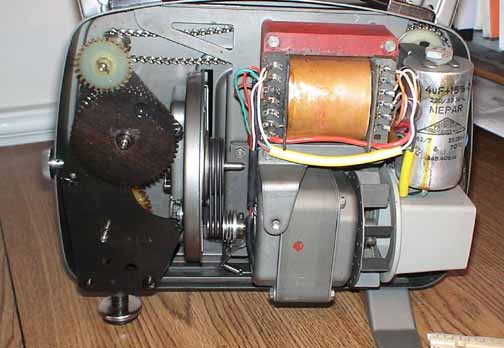
I use my 18-5 exclusively for projecting my old family 8mm Kodachrome’s, a task which it never fails to perform faultlessly, to the amazement of friends and family alike, who never knew that 8mm Kodachrome projected on a fine machine like this, could look better than HD video.
Summary:
Bolex 18-5 projector, beautiful looking compact projector with superb Swiss precision design and solid all metal build quality, excellent performer in all respects, with smooth quiet and rock steady film projection. Will probably last 200 years!
Very highly recommended.
[ January 19, 2015, 12:03 PM: Message edited by: Paul Adsett ]
Posted by Mark Todd (Member # 96) on January 18, 2015, 03:59 PM:
Hi Paul What type of Motor do these use please just out of interest.
Many Thanks Mark.
Posted by Paul Adsett (Member # 25) on January 19, 2015, 12:05 PM:
Sorry Mark I have no details on the type of motor.
Posted by Steve Klare (Member # 12) on January 19, 2015, 12:17 PM:
It looks like an AC motor to me.
This comes under the category of "they don't build them like this anymore", as least as far as consumer products go.
Yes, you actually can still buy equipment that's built this way: it's all commercial grade quality (and durability, and price).
(-and that folks, is why we're getting a new microwave today...)
Posted by Mark Todd (Member # 96) on January 19, 2015, 07:47 PM:
One of these if it has the brushless motor would be handy for me with my neighbour TV boost issues.
Thanks Mark.
Anyone got a nice one with the 12.5mm lens for sale in the UK please.
Thanks Mark.
Posted by Steve Klare (Member # 12) on January 19, 2015, 08:24 PM:
I'm seeing a substantial looking capacitor in the picture. I can't imagine why a silent machine would need one other than for an AC (brushless) motor.
Posted by Andrew Woodcock (Member # 3260) on January 20, 2015, 03:45 AM:
Yes it can only be for the AC motor Steve, to produce a phase lag or shift as often found on single phase motors.Some single phase motors use a much smaller starter capacity and a centrifugal force rotational switch mechanism to just create the phase lag on start up, then when reaching a certain speed the switch flicks over due to centrifugal force and takes the capacitor out of circuit, but this looks like the type where the capacitor stays in circuit while ever the motor is running.
Very large motor it has to be said for a projector of its size and reel capacity. No doubt these probably will last 200 years if not longer with a periodic change out of the capacitor.
Posted by Maurice Leakey (Member # 916) on January 20, 2015, 03:52 AM:
A word of warning for anyone contemplating a purchase from eBay.
Make sure there is a mains lead included.
For some reason, few sales include the lead. The lead mounted socket is no longer a current item and modifications are needed if you wish to convert what is still available.
Also, the lamps will cost over £20 each.
Posted by Paul Adsett (Member # 25) on January 20, 2015, 06:59 AM:
My experience with the bulbs Maurice, is that they seem to last a very long time.
My swimming pool pump motor is just like Andrew describes, you can hear that centrifugal switch click in and out when starting or stopping the motor.
Posted by Paul Mason (Member # 4015) on January 20, 2015, 07:01 AM:
It is worth mentioning that the two Super 8 versions are auto threading and can be recognised by the lack of ventilation slots on the side of the lamphouse as they were moved on to the top.
There is no dual format model.
The later Super 8 model is the 18-5L and has a square switch bezel and takes a 12V 75W lamp which in "diving helmet" or "spaceman" form is virtually unobtainable.
http://www.bolexcollector.com/projectors.html
Posted by Mark Todd (Member # 96) on January 20, 2015, 07:30 AM:
Hi must get one then, they are obviously not rare as I think at least 3 like Maurice says without the lead !!! on ebay UK at the moment, I wonder why so many like that ?
Anyway hope someone has one, as hate buying off ebay as anything is possible.
Best Mark.
PS Paul is there a palce in the UK to find those belts/ O rings you are aware of please.
Posted by John Richard Almond (Member # 2939) on January 20, 2015, 10:03 AM:
If you have a decent good old fashoined handy man stores near by you will defo get a drive belt...(O ring)
Posted by Mark Todd (Member # 96) on January 20, 2015, 10:43 AM:
Its funny its listed on the super 8 data base as a magnetic motor, thats usually meaning one with Brushes.
Can anyone be sure of its type.
Means I can use it before 12 ish at night if AC synchronus.
Thanks Mark.
Posted by Steve Klare (Member # 12) on January 20, 2015, 11:07 AM:
Well,
The Super-8 Database lists Elmo ST-1200 as having "Magnetic Motor" and we know that's brushless.
Elmo ST-180 M 2-Track is "DC magnetic motor" and that is a brushed motor.
Eumig Mark S 810 D has "AC magnetic motor" (brushless).
Any practical electric motor that's ever been built has been "magnetic" so calling them this is actually kind of silly!
I suppose we could have a little boiler with an electric heater and a piston to drive the machine, but would our audiences wait around while we build up steam? (This is a projector I would HAVE to own! I want the one with the whistle!)
I stand by what I said about that capacitor. It looks like a motor cap and that means an AC motor. If it was much lower in voltage and much higher in microfarads and it was a sound machine I'd guess it was a filter cap for the sound board, none of these are true.
Paul? Could you do us an experiment?
Set up an AM radio right next to your Bolex, run the machine and see what kind of interference you pick up?
Even with a decent set of brushes my DC machines flunk this one as the radio gets close. With a worn set I was getting interference 3 rooms away. (Mark, could this be your real problem?)
Posted by Andrew Woodcock (Member # 3260) on January 20, 2015, 11:39 AM:
by Magnetic, I presume it means the rotor turns just by magnetism alone e.g. no physical contact to it unlike any motor that requires brushes. All AC induction motors work this way (apart from Asynchronous type with salient pole rotor) so from the description I am going with Steve's conclusion that a magnetic motor as described on the data base means AC induction as opposed to D.C. brush/ commutator arrangement. I agree also with Steve in that calling any motor a "magnetic" type is absolute nuts as like Steve says all motors rely on magnetic fields to rotate by one principle or another
Posted by Steve Klare (Member # 12) on January 20, 2015, 11:52 AM:
They could do an electrostatic motor I suppose, but you won't catch me in the same room! High voltage and high power are a combination I can live without!
I wonder how they get 5 FPS out of this?
Posted by Andrew Woodcock (Member # 3260) on January 20, 2015, 12:35 PM:
Good point Steve as from the photograph it appears a very simple but better arrangement than a lot of projector drive chains, where the motor drives the shutter directly by what appears to be 3 seperate drive belts.
Maybe Paul will be able to tell us more.
To me it appears that the belts are running on the motor shaft and not the motor pulley but I guess I am missing something from what I can see from the photo.
Posted by Mark Todd (Member # 96) on January 20, 2015, 01:56 PM:
I think as you lads say with the very large capacitor, I think that might even do my tumble drier.
Anyway on the lookout for a nice one if anyone fancies a spring clean.
Best Mark.
Posted by Paul Adsett (Member # 25) on January 21, 2015, 11:07 AM:
Here is a close up pic of the 18-5 drive arrangement:
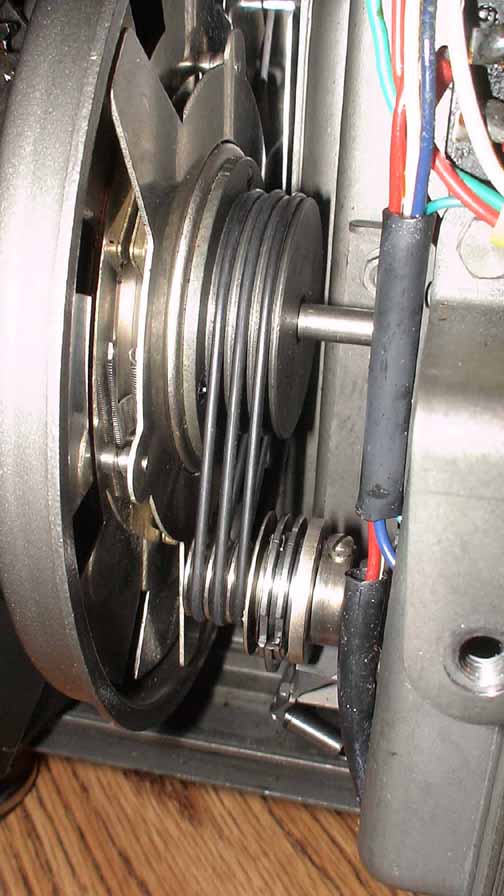
The motor runs at a constant fixed speed, and a mechanical clutch arrangement on the motor shaft, activated by a linkage from the main control knob, reduces the motor shaft rotation by a factor of 5/18 when the knob is turned to the 5fps position. This is a very clever design and I can't tell how it works without taking it apart, which I am not about to do.
Three belts, mounted on pulley grooves in the motor shaft connect to three corresponding pulley grooves on the shutter/cam shaft. I have no idea why three belts were used as they all rotate together, but whatever it works well. The shutter itself is actually three shutters, each with three blades. They are mounted one behind the other, and two of the blades are weighted and spring loaded so that at 18fps centrifugal force on the weights overcome the spring force and all three shutters swing into alignment, and you have a normal three bladed shutter. At the 5fps speed the spring load on the shutter dominates and the shutters all line up between each other, and you have a 9-bladed shutter, which results in no flicker at the 5fps speed.
The whole thing is devilishly clever, and works like a charm. Another example of brilliant Bolex design.
Posted by Andrew Woodcock (Member # 3260) on January 21, 2015, 02:04 PM:
Thanks for the in depth explanation Paul! That was really interesting and truly an ingenious design by Bolex, very clever indeed!
Posted by Mark Todd (Member # 96) on January 21, 2015, 06:54 PM:
Yes thanks form here too Paul, nice pic as well.
Best Mark.
Posted by Paul Adsett (Member # 25) on January 21, 2015, 08:10 PM:
Thanks Guys. I investigated that clutch on the motor shaft a little further, and by turning the whole thing by hand I found the following:
1. At the normal 18fps setting of the control knob there is a direct 1:1 drive from the motor shaft through the clutch to the pulley.
2. At the 5 fps setting the knob activates a little lever which causes the clutch to decouple the motor shaft for a part of every motor revolution. So I conclude that at 5fps the shutter and claw cam actually pause during one cycle of the motor shaft.
The centrifugal shutter is very ingeneous an it occurs to me that Beaulieu used a similar principle for 18fps on their sound projectors. Am I correct about that Andrew?
Ran a roll of 1962 Kodachrome 2 through my 18-5 tonight and it looked fantastic, with the 18-5 delivering a rock steady pin sharp picture with zero fuss at all. Ran just like it came from the factory. ![[Smile]](smile.gif)
Posted by Barry Fritz (Member # 1865) on January 21, 2015, 08:31 PM:
I agree with Paul that they are great machines. I had one of each different version of them but now just have an 18-5 and 18-5L Super(newer version). I just wish the Super was not an autoload as I prefer manual loading also. The motors are brushless.
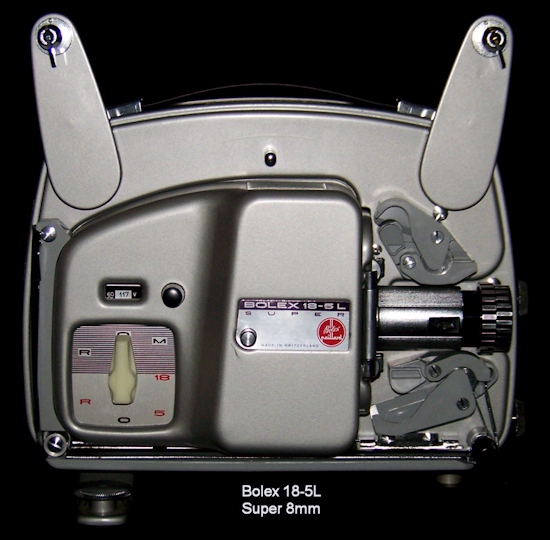
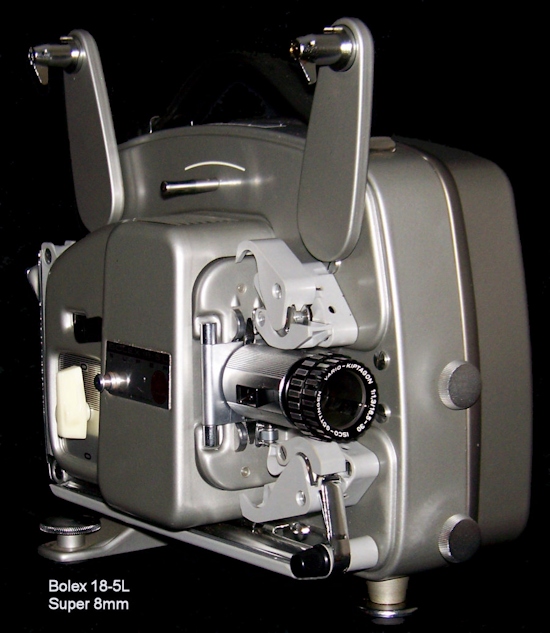
Posted by Paul Adsett (Member # 25) on January 21, 2015, 10:43 PM:
Both are great looking machines Barry.
Posted by Andrew Woodcock (Member # 3260) on January 21, 2015, 11:23 PM:
In answer to Paul's earlier question regarding the Beaulieu shutter mechanism at 18fps, on my 2/3 bladed machine, each blade is just in a fixed and set position either 120 or 180 degrees apart depending on which mode you are using the machine in.
Quite possibly on the fixed 3 bladed earlier mono / duo track versions, there will be a similar centrifugal force mechanism as you are describing Paul, but having never owned one of those machines, I wouldn't know for sure. Maybe someone like Rob could enlighten us?
The Bauer machines use a similar principle to what you are describing, whereby the shutter is bigger on 18fps than at 24fps by having a smaller set of blades being mounted behind the main shutter blades by virtue of an elongated slot on the hub.
What happens here is at 18fps there is insufficient force to move the added shutter pieces behind the main shutter blades therefore creating a much greater angle of shutter at the slower speed
This in turn, produces a very slightly dimmer image but keeps the image flicker free at the slower speed of 18fps.
At 24fps, the small extra pieces of shutter blade move behind the main shutter blades due to the extra centrifugal force and therefore allow more light to pass through the gate and onto the screen.The image still remains equally flicker free to the eye due to the increase in speed
Posted by Paul Adsett (Member # 25) on January 22, 2015, 07:04 AM:
Thanks for that clarification Andrew.
I notice a couple of things on Barry's machine that is different from mine. First, I do not see the knurled frame adjusting knob which is part of the gate hinge on my machine. So is there no framing provision on the later versions?
And what is that knob for at the bottom front of the projector? Is it for front foot height adjustment, which on my machine is accomplished by a black knob which is coaxial to the front bottom film roller.
Posted by Barry Fritz (Member # 1865) on January 23, 2015, 06:52 PM:
Hi Paul. The black knurled knob is for height control just as yours is. The framing is done via the lower chrome knob on the front of the machine. I have no clue why they changed it from the original 18-5. Perhaps for those that had lost a user manual could figure out how to adjust the frame. I know the one at the gate on the 18-5 is not at all obvious.
On another note, the first 18-5 (the one with the red speed knob) had just one flat belt.
Posted by Paul Adsett (Member # 25) on January 23, 2015, 07:54 PM:
Thanks for that info Barry.
Yesterday I pulled the back off my 18-5 to do some lubrication and I noticed the following:
1) The sponge foam padding around the power sockets at the inside rear of the projector were totally crumbling. I vacuumed it all up and scraped out what was left before it could get into the mechanism. This foam pad really serves no useful purpose anyway.
2) While I was doing this I noticed that some rust had formed on the external metal parts of the power sockets inside the rear of the machine. My intention here is to clean off the rust and paint the area with grey Rustoleum paint. Fortunately there is no damage at all to the exterior finish of the machine. So this is one to nip in the bud if you have one of these machines.
Posted by Barry Fritz (Member # 1865) on January 23, 2015, 11:31 PM:
Paul. What you describe is common. I replaced the foam on all the machines I had although you are correct, it serves no real purpose. Some of them had rust under where the foam was. The glue must have had something to do with that.
Posted by Bryan Chernick (Member # 1998) on January 24, 2015, 12:10 AM:
Great report Paul! I have 2 18-5's, an 18-5 Super and an 18-5L. I agree that the Super 8 models would be better with manual feed like the 18-5. I love these projectors and have bought and sold a few, mostly to upgrade to one in better condition. I have had problems with a few that I think is worth mentioning. One problem is the selector switch, I've had one where the switch would stop responding then start working again. I could never figure out how to fix it with my limited knowledge of electronics. Another problem I ran into was a lack of voltage getting to the bulb. I know others have had these same problems, for me the solution was getting one in better working condition.
They do run nice and quiet, especially compared to the M8. If I had to choose between an 18-5 and the M8 I would choose the M8, good thing I don't have to make that choice. Besides being a beautiful projector the M8 has a few features that I wish they carried over to the 18-5., the obvious being variable speed. The other is the small wheel under the gate that helps keep the bottom loop when a splice gets stuck. I don't know why this wasn't a feature on many other projectors, it works great.
The 18-5 does have a size advantage over the M8 and they run great. By the way, I have purchased the original type of square belts on eBay a few times, I see them being sold on there frequently. It is cheaper to get the O-rings, they work just as well. If someone knows the exact O-ring size it would be nice to add that to this thread. I also had the original version of the 18-5 with the flat belt, those belts can be hard to find, almost as hard as a new cord.
Posted by Paul Adsett (Member # 25) on January 24, 2015, 09:47 AM:
Thanks Bryan, I agree about the M8, a stunning looking machine.
The 0-rings that I used on my 18-5 are as follows:
Material: Butyl B612 rubber, or Ethylene Propylene rubber.
Hardness: 50 durometer
Inside Diameter : 1.66 ins
Wall thickness: 0.070 ins
Available from Parker Hannifin Seal Company USA and Worldwide.
Do any of you guys also have the Bolex -Paillard white leatherette carrying cover for the 18-5? I was lucky as my machine came with one, and I am wondering if it is a common item for these machines. My case is in excellent condition after 50 years, no sign of cracking or splitting. I keep it moisturized with an occasional application of ArmorAll.
Posted by Maurizio Di Cintio (Member # 144) on January 24, 2015, 12:10 PM:
I hate doing this, but if Andrew was referring to the Bauer/Silma projectors (Studioklasse and cheaper), their shutters are supposed to work in a totally different way: in fact regardless of the speed, the shutter's blade will have the same dimensions when the projector runs in forward. When in reverse, the additional blades, which in FWD mode remain hidden by the main blades, switch in position thus enlarging the main blades; that's to prevent ghosting on part of the screen in reverse, because that would happen with these machines, given the peculiar shutter cam, which provides a very fast claw arm movement; which is great in FWD mode but would lead to a certain degree of ghosting were it not for this feature. As a proof you can just watch the same footage in FWD mode at different speeds: the screen brightness will be the same. But in reverse there will be a slight decrease in brightness again at both speeds. Eumig 936, 938 and 940 copied the same concept. Eumigs Series 800, due to their claw being so tiny, give some ghosting in reverse on the lower side: they would have benefited of such a feature; still they're a good way to see with your eyes what I really mean, if you own a Eumig Series 800.
Anyway, Paul, I really appreciated your article in this Bolex model. Thanks for sharing.
Posted by Barry Fritz (Member # 1865) on January 24, 2015, 02:50 PM:
I had the cream colored leatherette case on a couple of the 18-5s that I sold. They were in nice condition. I have a gray one on my 18-5L and it is great condition. I have the factory hard case for the 18-5 I still have.
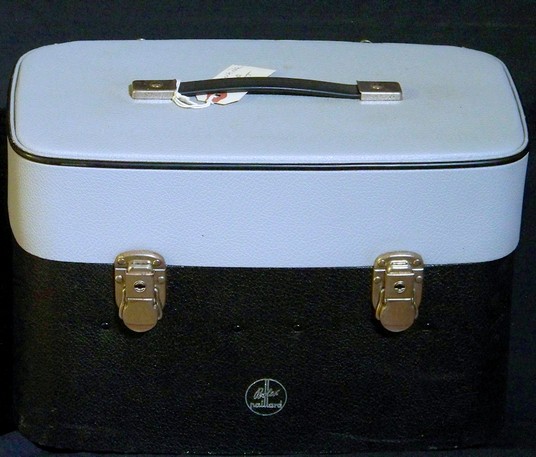
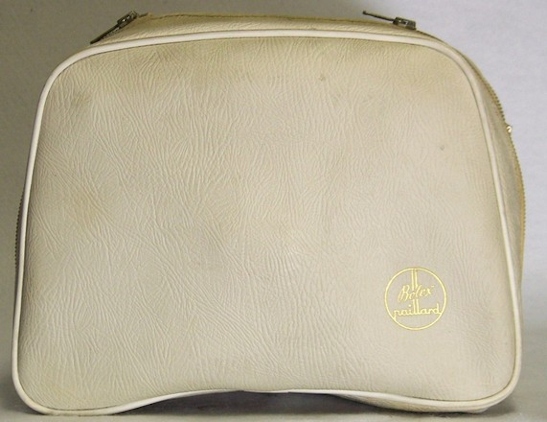
Posted by Bryan Chernick (Member # 1998) on January 25, 2015, 12:39 AM:
Wow Barry, your hard case is in excellent condition. I have two of them but mine are in just ok condition. I have a few of the soft cases but I definatelly like the hard case better. I had one soft case that was falling apart and the zipper sticks on most of them. I put bees wax on the zipper and that helped a lot.
Posted by Barry Fritz (Member # 1865) on January 25, 2015, 09:22 AM:
Bryan, I had to reline the inside of the case with new foam but otherwise it is in great condition. The wax is a good tip for those old zippers. I did same but just used a birthday candle to get the wax on. I imagine most Bolex fans are aware of the Bolex collector site, but if not, here it is:
http://www.bolexcollector.com/projectors.html
Posted by Mark Todd (Member # 96) on January 30, 2015, 02:37 PM:
Well we just got a std 8 one with the auto feed version, a few films( silent of sounds though but still fun ), lovely order, the origional lead, runs well and lovely order in its origional carry case as well, and the 12.5mm lens quite cheap overall.
Its really more for with the kids and my eldest son thinks its amazing, showing people pics of it on his phone !!! the old and the new !!!
Hes buzzing about taking it in to college to run a few films on as well.
Sadly the back of the bulb the silver has fallen off but its still working just a little dim as loosing light both ways.
Has anyone got a bulb or two in the odd drawer etc they could sell at normal people levels please possibly.
Going to get some belts as well and I can see this little beauty staying between the 3 lads for a long time.
It simply oozes qaulity !!!, runs so quietly, but needs to work off that never run for 30-40 years type smell a bit.
Its stood out up being looked at whenever its passed right now.
Best Mark.
PS Hi Barry can you take off the film channel etc after the 2nd sprocket totlly so open like the 18-5 autoload only std 8 version, as those channels usually are flat amd mark the film running through or are the channels recessed please.
Thanks Mark.
Posted by Mark Todd (Member # 96) on February 02, 2015, 06:12 PM:
Can anyone give me some service advice please for the 18/5.
Looking in the back its minty but there is some light yellow dust on the fan. Are there any asbestos issues on these ? models.
I know these tend to give an odd smell out of the cooling fan at the back, its not like a carbon brush smell, but similar.
It still has the 3 origional sqaure belts, over 50 years old !!!
Are there any oiling, or greasing points that are important, can you use silicon fett on it please.
ETC ETC any advice greatly appreciated. Ryan who`s 21 is over the moon with it.
Thanks in advance etc.
Best Mark.
Posted by Paul Adsett (Member # 25) on February 02, 2015, 06:40 PM:
Hi Mark, as Barry and I mentioned earlier, the foam padding around the mains connector on the inside rear wall of the machine, is probably crumbling into dust. I would advise poking this out of the machine and cleaning up all the residual foam crumbs from the inside before they migrate into the mechanism and cause havoc. I am really suprised that you still have the original drive belts. I would advise replacing them with Butyl or EP O-Rings, as noted in the above thread.
There are no asbestos issues that I am aware of with this machine.
A single drop of machine oil on the internal shaft bearings, and some grease on the gears will ensure smooth running of the projector for years to come. Clean each of the fan blades and fan baffle. Regularly clean and polish the gate and film path with a little furniture polish on a cloth or Q-tip, and you will never scratch a single frame of film with this fine machine.
Posted by Mark Todd (Member # 96) on February 03, 2015, 04:01 AM:
Thanks Paul thats great.
I`d really forgotten just how nice these are.
Theres a heck of lot of projector there for a few bob.
I`ll have a go at the foam etc at the weekend.
Best Mark.
PS is there a visual way looking at the projector to tell if the super 8 one has the EFN halogen bulb please. Thanks.
[ February 03, 2015, 05:06 AM: Message edited by: Mark Todd ]
Posted by Mark Todd (Member # 96) on February 03, 2015, 04:49 PM:
Nice !!!
http://www.ebay.co.uk/itm/Vintage-Bolex-M8-Cine-Projector-Mint-/261758007315?pt=UK_Photography_Film_Projectors&hash=item3cf1fe3813
Best Mark.
Posted by Janice Glesser (Member # 2758) on February 03, 2015, 07:34 PM:
Mark...other than different lenses on my two projectors I don't see anything to identify that the one on the left came with an EFN bulb.
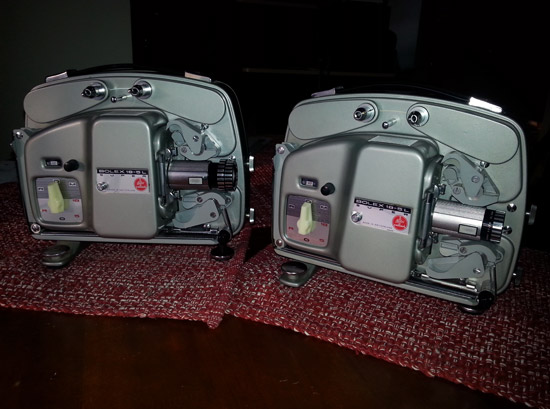
[ February 04, 2015, 12:59 AM: Message edited by: Janice Glesser ]
Posted by Mark Todd (Member # 96) on February 03, 2015, 08:23 PM:
They look nice Janice ! and thanks.
Is there possibly a difference in the label on the end that mentions the lamp etc, maybe the lamp shape or something.
Do you get the odd metally smell out of them when projecting. I wonder if ours just needs to be used more.
Though I will clean out the dust etc this weekend.
Best Mark. Thanks.
Posted by Janice Glesser (Member # 2758) on February 03, 2015, 10:46 PM:
The end labels are identical on both Mark. Mine don't have the smell you mention, but I have had smelly projectors. I just clean them up with alcohol and GooGone...and yes running them has helped. I also clean the case inside and out to get rid of some that musty smell. Something like Armor-all can also shine it up and make it smell good.
Posted by Bryan Chernick (Member # 1998) on February 04, 2015, 05:11 PM:
The only way to tell which bulb an 18-5L uses is to open the bulb cover and look at it. There is a conversion kit but they are hard to find these days. I think Urbanski Film used to sell them but I don't see them on the web site anymore. When I was looking for an 18-5L on eBay years ago I sent a message to the seller and asked them to send or post a picture of the bulb.
Posted by Barry Fritz (Member # 1865) on February 04, 2015, 07:11 PM:
Chambless Cine equipment used to do the socket adaption but they don't do it anymore due to lack of parts. The adapters were listed on Ebay a while back for 250.00. I had one laying around and sold it for 50.00 on Ebay. Here's a pic. It goes right into the lamp socket. I've often wondered that if someone was really creative, if they could take the base of an old lamp and with other parts, fashion one of these.
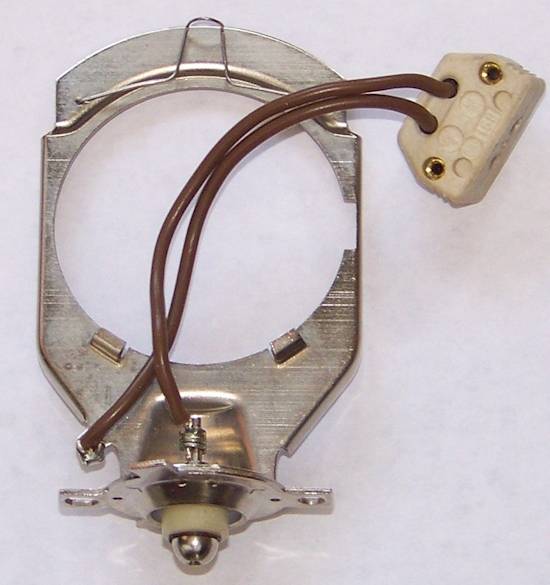
Posted by John Hunter (Member # 4925) on August 06, 2015, 10:51 AM:
I dont know if I am too late with this info, but here goes. I have been reading the ACW test report on the 18-5 projector, in the march 8 1962 issue. First the motor is listed as "induction type"
and says to reduce speed for 5fps a resister is switched into the motor circuit. It was tested alongside an M8R, both fitted with new lamps, and the 18-5 gave a brighter picture on the 36 inch screen. They also mention that the 18-5 has a 2 pin claw, while the m8r has only one pin, hence they say the reason for the loop restorer on the M8R. I also remember reading, but dont know where, that the 3 drive rings on the 18-5 were because the single ring gave trouble, dont know what, but Bolex made the drive into 3 rings, and if 18-5s were taken to the retailer, they would be modified free of charge. I bought mine from a "car boot sale" for £8, as new, and fitted with 3 drive rings. I have just received this morning 3 A/17 lamps, with vat and posting cost, at £18.14 each.
Posted by Bryan Chernick (Member # 1998) on August 06, 2015, 10:43 PM:
John, the first 18-5 models had a single flat belt rather than the three "O-rings". I had one for a while but ended up selling it. It's very hard to find a replacement belt for them. I'm glad they switched to the O-rings. They can be found at your local hardware store.
Posted by John Hunter (Member # 4925) on August 07, 2015, 04:17 AM:
Bryan. Thanks for that. Have you got another 18-5 for your 8mm films, or a different make. I ran a film taken in 1963 the other night on a cirse machine, good bright picture, but not quite as steady as on the 18-5. I hope the Italian firm bring out standard 8 as well as super 8 & 16mm films. and at the right price.
Posted by Bryan Chernick (Member # 1998) on August 07, 2015, 11:26 PM:
I have two Regular 8mm 18-5's, an 18-5 Super and an 18-5L. I also have an M8. Obviously I have a thing for Bolex projectors.
Ferrania has no plans to make Regular 8mm film at this time, just Super 8. I suspect Whitner in Germany will perforate some of the Ferrania 16mm into Regular 8mm since they have the machine to do that.
Posted by Geoffrey Radnor (Member # 5866) on August 18, 2017, 11:48 AM:
I have been given a Bolex 18-5 Super to sell for a friend. With 3 new belts and a good bulb. Includes two cords the manual and the original bill of sale. Totally excellent condition.
Location Ottawa, Canada
Posted by Janice Glesser (Member # 2758) on August 18, 2017, 01:40 PM:
The Bolex 18-5 is a lovely classic silent projector.
Visit www.film-tech.com for free equipment manual downloads. Copyright 2003-2019 Film-Tech Cinema Systems LLC

UBB.classicTM
6.3.1.2



![[Smile]](smile.gif)





